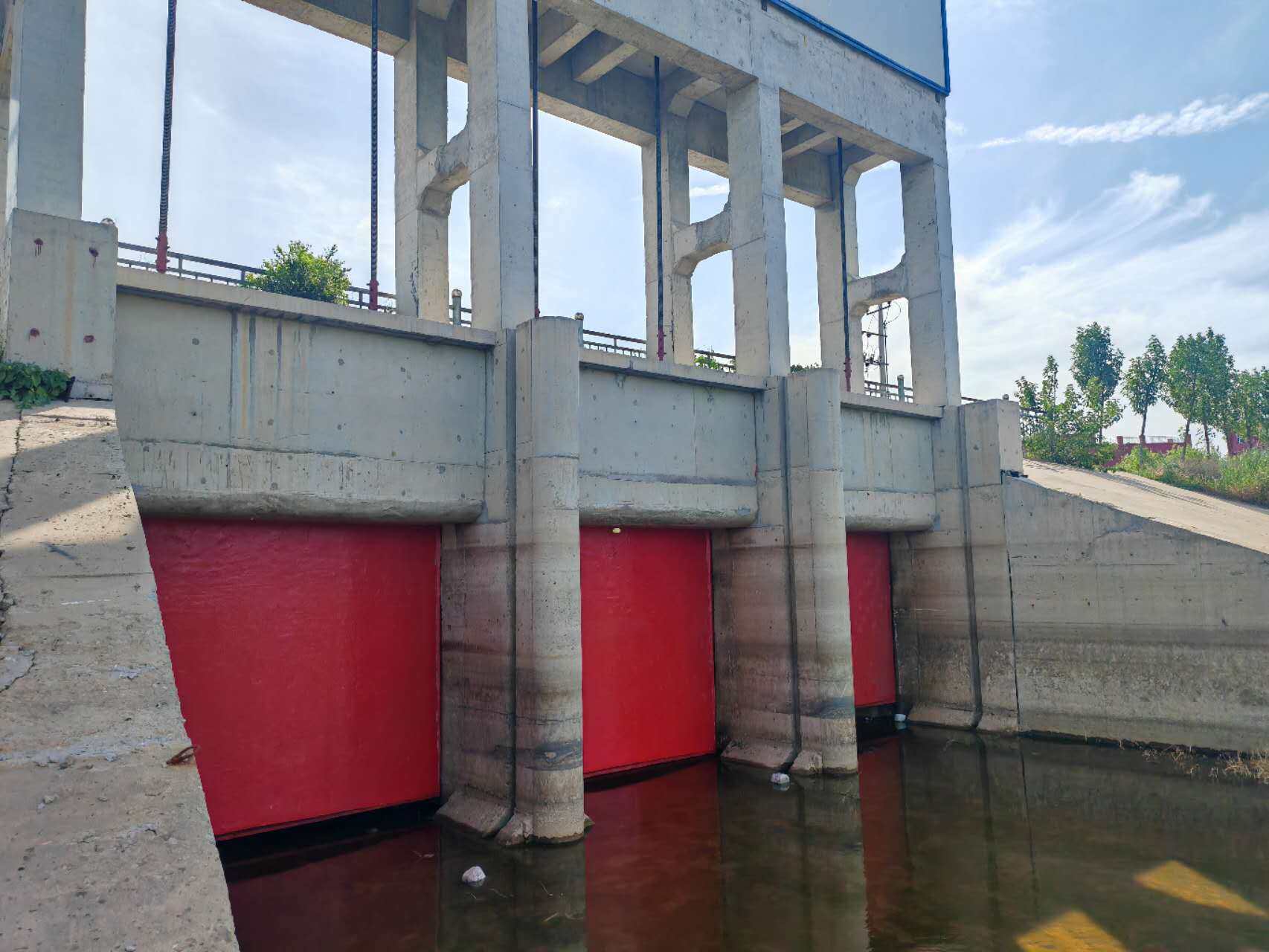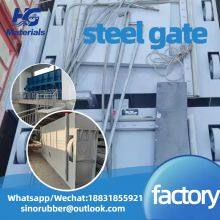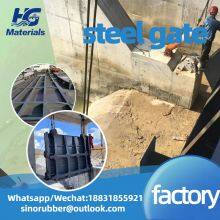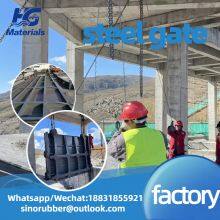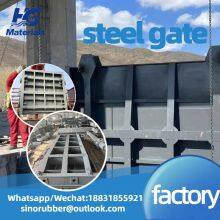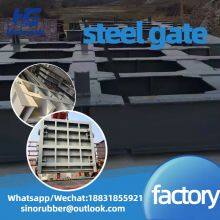Hydraulic Machinery Equipment for Controlling Water Levels and Regulating Flow, Reservoir Channel Steel Gate Hoist
# Steel Sluice Gates: Robust Solutions for Water Flow Control Steel sluice gates are high-performance hydraulic control structures widely used in modern water conservancy, municipal, industrial, and environmental engineering projects. Renowned for their exceptional strength, adaptability, and long service life, they address the demands of large-scale, high-pressure water management scenarios where durability and precision are critical.
## 1. Material Characteristics & Construction Crafted primarily from high-quality steel alloys—including carbon steel (for general applications) and stainless steel (for corrosion-prone environments like seawater or chemical wastewater)—these gates leverage steel’s inherent advantages: high tensile strength, resistance to impact and wear, and compatibility with anti-corrosion treatments (e.g., hot-dip galvanizing, epoxy coating, or cathodic protection).
A standard steel sluice gate consists of four core components: - **Gate Leaf**: A rigid, plate-like structure (often reinforced with ribs for added stability) that directly blocks or regulates water flow. Its surface is precision-machined to ensure tight sealing. - **Frame**:
A fixed steel structure embedded in channels, dams, or pipelines, guiding the gate leaf’s movement (vertical lifting, horizontal sliding, or tilting) and forming a leak-proof interface with the leaf via rubber or metal sealing gaskets. - **Operating Mechanism**: Tailored to gate size and application—options include manual handwheels (for small gates), electric hoists (for medium-sized units), or hydraulic cylinders (for large, heavy gates requiring high lifting force). - **Safety & Control Accessories**: Limit switches (to prevent over-lifting/lowering), pressure sensors, and remote monitoring systems (for automated operation in remote or hazardous areas).
## 2. Operational Principle Steel sluice gates control water flow through controlled movement of the gate leaf: - **Water Retention/Blockage**: When fully lowered (or closed), the gate leaf presses against the frame’s seals, creating a watertight barrier that stops water flow—ideal for isolating pipeline sections, storing water in reservoirs, or preventing flooding. - **Flow Regulation**: By partially lifting (or opening) the gate, operators adjust the gap between the leaf and frame, precisely controlling downstream flow rate and water level. This is critical for irrigation, hydropower generation, or maintaining ecological base flows in rivers. - **Emergency Response**: Their robust structure and rapid operation (especially with electric/hydraulic mechanisms) allow quick adjustments during floods or equipment failures, minimizing disaster risks.
## 3. Key Applications Steel sluice gates excel in diverse, high-demand scenarios: - **Large-Scale Water Conservancy**: Installed in dams, reservoirs, and river diversion projects to manage water storage, flood control, and downstream water supply. Their ability to withstand high hydrostatic pressure (up to tens of MPa) makes them suitable for deep-water applications. - **Municipal Infrastructure**: Used in urban drainage systems, sewage treatment plants, and water supply networks. Stainless steel variants are preferred here to resist corrosion from wastewater or chlorinated drinking water. - **Industrial Sector**: Critical for power plants (controlling cooling water flow), chemical facilities (regulating process water or treating industrial effluent), and mining operations (managing tailings water or mine dewatering). - **Navigation & Shipping**: Integrated into canals, locks, and ports to adjust water levels for safe vessel passage, ensuring consistent depths for ships and barges. - **Ecological Engineering**: Deployed in river restoration projects to mimic natural flow regimes, supporting aquatic habitats by controlling sediment transport and maintaining stable water levels.
## 4. Advantages Over Alternative Gates Compared to cast iron or rubber gates, steel sluice gates offer distinct benefits: - **Higher Load-Bearing Capacity**: Steel’s strength allows for larger gate sizes (up to tens of meters in width/height) and operation in high-pressure environments. - **Flexible Corrosion Protection**: Multiple anti-rust treatments extend service life (often 30–50 years) in harsh conditions, outperforming uncoated cast iron. - **Easier Customization**: Steel can be welded, cut, and shaped to fit irregular channel/pipeline sizes, adapting to unique project requirements. - **Low Long-Term Maintenance**: Unlike rubber gates (which require frequent replacement of flexible parts), steel gates only need periodic inspection of seals and lubrication of moving components.
## 5. Maintenance Recommendations To ensure optimal performance: - Conduct quarterly inspections of seals (replace worn gaskets promptly to prevent leakage). - Clean gate surfaces and frames regularly to remove sediment, algae, or debris that could hinder movement. - Inspect anti-corrosion coatings annually; touch up scratches or peeling to prevent rust. - Test operating mechanisms (especially emergency stops and backup power) monthly to ensure responsiveness. In summary, steel sluice gates are indispensable for modern water management, combining structural robustness, operational precision, and environmental adaptability. They provide reliable, long-term solutions for balancing water supply, flood control, industrial needs, and ecological sustainability across diverse sectors.

Send Inquiry to This Supplier
You May Also Like
-
Hydraulic-Operated Low-Carbon Steel Sluice Gate River Gate Valve With Hinge & Hoist for River Irrigation System - Direct ManufacturerUS$ 100 - 3000MOQ: 10 Combos
-
Corrosion-Resistant Steel Sluice Gate River Gate Valve for River Water Flow Control & Wastewater Treatment Plant - In-Stock SupplierUS$ 100 - 3000MOQ: 10 Combos
-
High-strength Steel Hydraulic Gate River Gate Valve With Calibration Kit for River Hydropower Station Water ControlUS$ 100 - 3000MOQ: 10 Combos
-
Heavy-Duty Low-Carbon Steel Sluice Gate River Gate Valve With Leakage Detection Design for River Flood Defense & Reservoir OperationUS$ 100 - 3000MOQ: 10 Combos
-
Hydraulic Steel Sluice Gate River Gate Valve With Reinforced Gate Leaf for River Irrigation Canal Flow RegulationUS$ 100 - 3000MOQ: 10 Combos
-
Corrosion-Resistant Cast Iron & Stainless Steel Sluice Gate for Wastewater TreatmentUS$ 100 - 3000MOQ: 10 Combos
-
Arc-shaped Sluice Gate, River Water Diversion for Hydroelectric Power and IrrigationUS$ 550 - 690MOQ: 1 Combo
-
Arc Gate Steel Gate, Arc Gate, Sewage Treatment Steel Gate, Reservoir Hydraulic Steel Gate ValveUS$ 550 - 690MOQ: 1 Combo
-
Arc Gate Sewage Treatment Hydropower Station Overflow Dam Discharge Steel Gate Reservoir Hydraulic Arc GateUS$ 550 - 690MOQ: 1 Combo
-
Manufacturer Supplies Curved Steel Sluice Gates, Sliding Steel Gates for Reservoirs and Rivers, and Double-leaf Steel Lifting Curved Gates.US$ 550 - 690MOQ: 1 Combo


